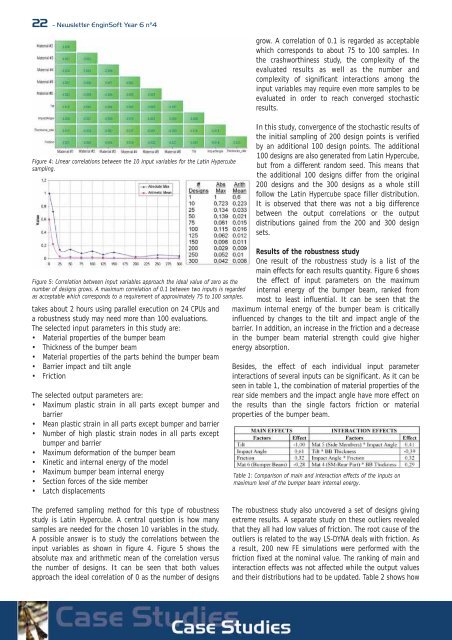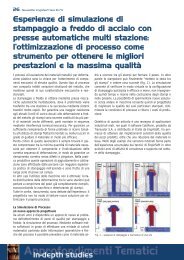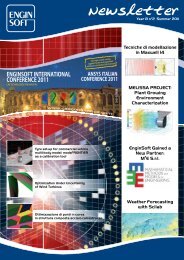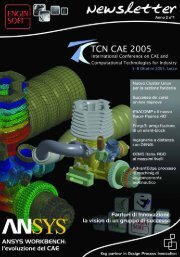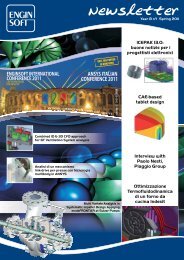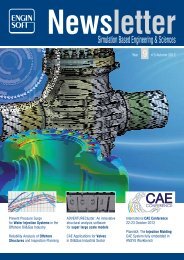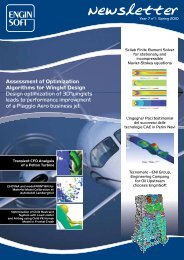software training courses 2010 corsi di addestramento ... - EnginSoft
software training courses 2010 corsi di addestramento ... - EnginSoft
software training courses 2010 corsi di addestramento ... - EnginSoft
You also want an ePaper? Increase the reach of your titles
YUMPU automatically turns print PDFs into web optimized ePapers that Google loves.
22 - Newsletter <strong>EnginSoft</strong> Year 6 n°4<br />
Figure 4: Linear correlations between the 10 input variables for the Latin Hypercube<br />
sampling.<br />
Figure 5: Correlation between input variables approach the ideal value of zero as the<br />
number of designs grows. A maximum correlation of 0.1 between two inputs is regarded<br />
as acceptable which corresponds to a requirement of approximately 75 to 100 samples.<br />
takes about 2 hours using parallel execution on 24 CPUs and<br />
a robustness study may need more than 100 evaluations.<br />
The selected input parameters in this study are:<br />
Material properties of the bumper beam<br />
Thickness of the bumper beam<br />
Material properties of the parts behind the bumper beam<br />
Barrier impact and tilt angle<br />
Friction<br />
The selected output parameters are:<br />
Maximum plastic strain in all parts except bumper and<br />
barrier<br />
Mean plastic strain in all parts except bumper and barrier<br />
Number of high plastic strain nodes in all parts except<br />
bumper and barrier<br />
Maximum deformation of the bumper beam<br />
Kinetic and internal energy of the model<br />
Maximum bumper beam internal energy<br />
Section forces of the side member<br />
Latch <strong>di</strong>splacements<br />
The preferred sampling method for this type of robustness<br />
study is Latin Hypercube. A central question is how many<br />
samples are needed for the chosen 10 variables in the study.<br />
A possible answer is to study the correlations between the<br />
input variables as shown in figure 4. Figure 5 shows the<br />
absolute max and arithmetic mean of the correlation versus<br />
the number of designs. It can be seen that both values<br />
approach the ideal correlation of 0 as the number of designs<br />
grow. A correlation of 0.1 is regarded as acceptable<br />
which corresponds to about 75 to 100 samples. In<br />
the crashworthiness study, the complexity of the<br />
evaluated results as well as the number and<br />
complexity of significant interactions among the<br />
input variables may require even more samples to be<br />
evaluated in order to reach converged stochastic<br />
results.<br />
In this study, convergence of the stochastic results of<br />
the initial sampling of 200 design points is verified<br />
by an ad<strong>di</strong>tional 100 design points. The ad<strong>di</strong>tional<br />
100 designs are also generated from Latin Hypercube,<br />
but from a <strong>di</strong>fferent random seed. This means that<br />
the ad<strong>di</strong>tional 100 designs <strong>di</strong>ffer from the original<br />
200 designs and the 300 designs as a whole still<br />
follow the Latin Hypercube space filler <strong>di</strong>stribution.<br />
It is observed that there was not a big <strong>di</strong>fference<br />
between the output correlations or the output<br />
<strong>di</strong>stributions gained from the 200 and 300 design<br />
sets.<br />
Results of the robustness study<br />
One result of the robustness study is a list of the<br />
main effects for each results quantity. Figure 6 shows<br />
the effect of input parameters on the maximum<br />
internal energy of the bumper beam, ranked from<br />
most to least influential. It can be seen that the<br />
maximum internal energy of the bumper beam is critically<br />
influenced by changes to the tilt and impact angle of the<br />
barrier. In ad<strong>di</strong>tion, an increase in the friction and a decrease<br />
in the bumper beam material strength could give higher<br />
energy absorption.<br />
Besides, the effect of each in<strong>di</strong>vidual input parameter<br />
interactions of several inputs can be significant. As it can be<br />
seen in table 1, the combination of material properties of the<br />
rear side members and the impact angle have more effect on<br />
the results than the single factors friction or material<br />
properties of the bumper beam.<br />
Table 1: Comparison of main and interaction effects of the inputs on<br />
maximum level of the bumper beam internal energy.<br />
The robustness study also uncovered a set of designs giving<br />
extreme results. A separate study on these outliers revealed<br />
that they all had low values of friction. The root cause of the<br />
outliers is related to the way LS-DYNA deals with friction. As<br />
a result, 200 new FE simulations were performed with the<br />
friction fixed at the nominal value. The ranking of main and<br />
interaction effects was not affected while the output values<br />
and their <strong>di</strong>stributions had to be updated. Table 2 shows how


